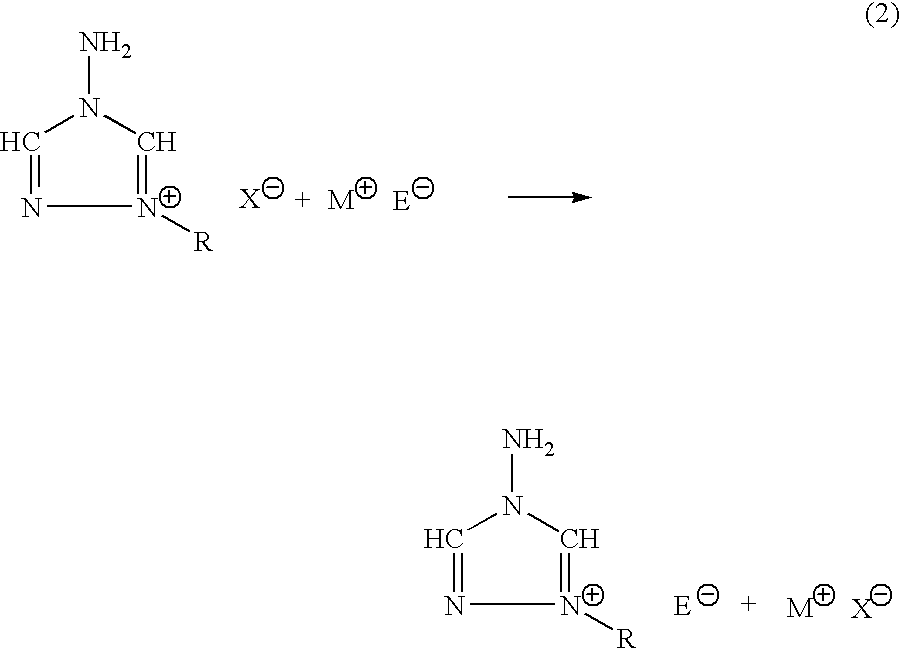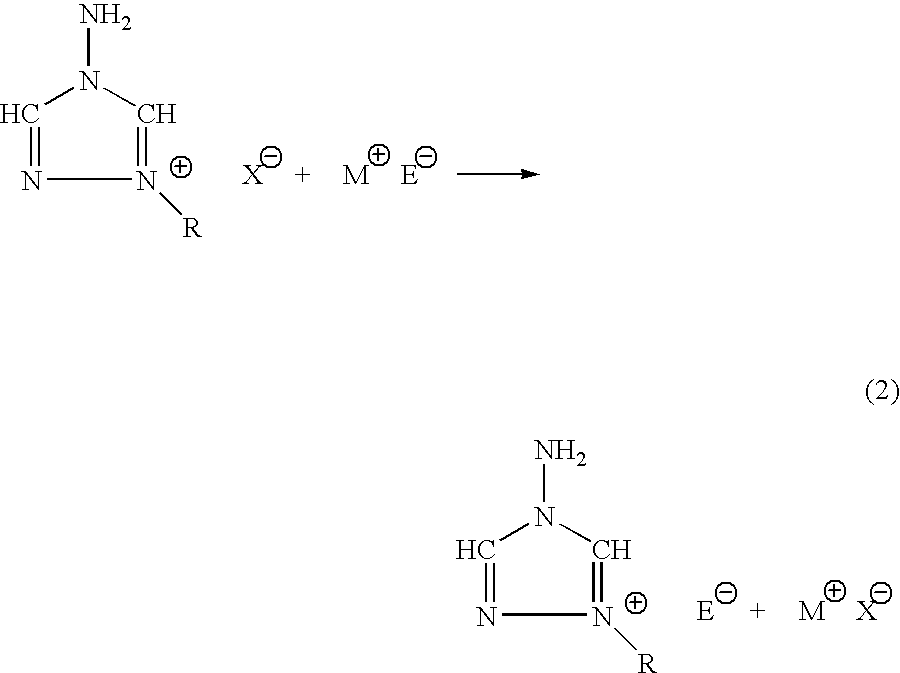Energetic ionic salts
a technology of ionic salts and ionic salts, which is applied in the field of energetic ionic salts, can solve the problems of high handling and transfer costs of ionic salts used in satellite control devices, high vapor toxicity, etc., and achieves simple experimental means, high yield, and high purity
- Summary
- Abstract
- Description
- Claims
- Application Information
AI Technical Summary
Benefits of technology
Problems solved by technology
Method used
Image
Examples
example 2
1-ethanol-4-amino-1,2,4-triazolium bromide
[0025]5.000 grams, 59.4 mmoles of 4-amino-1,2,4-triazole was dissolved in 200 ml of fresh acetonitrile and stirred vigorously. 29.800 grams of 2-bromoethanol was added slowly to the solution by pipet. After the addition was complete, the reaction mixture was heated for 20 hours at 80° C., until thin layer chromatography revealed that all of the 4-amino-1,2,4-triazole had been consumed. The reaction mixture was then allowed to cool to room temperature and then was rotary evaporated down to leave a viscous oil. Hot isopropyl alcohol was added to the oil dissolving it. Storage of the resultant solution in a refrigerator resulting in a large crop of a viscous oil of 1-ethanol-4-amino-1,2,4-triazolium bromide, 9.9332 g, 47.5 mmoles. Melting point 0-5° C.; DSC onset 180° C.
[0026]1H NMR (d4-MeOH): 3.956, 3.962, 3.969, 3.976, 3.981 (complex triplet, relative area 2.000), 4.495, 4.500, 4.508 (triplet, relative area 2.029), 4.834 (broad singlet, relat...
example 3
1-n-butyl-4-amino-1,2,4-triazolium nitrate
[0028]In a 125 ml Erlenmeyer flask, 2.7721 g, 12.5 mmoles of 1-n-butyl-4-amino-1,2,4-triazolium bromide was dissolved in 30 ml of fresh methanol and stirred vigorously. Silver nitrate, 2.1290 grams, 12.5 mmoles, was dissolved in 25 ml of fresh methanol and 2 ml of acetonitrile in a separate flask. The silver alcohol solution was then added slowly to the vigorously stirred solution of 1-n-butyl-4-amino-1,2,4-triazolium bromide. The silver nitrate flask was washed with three, five ml quantities of methanol, and subsequently transferred to the reaction solution. The reaction was allowed to stir an additional 45 minutes in the dark at ambient temperature. The silver bromide was filtered away and washed with three, five ml aliquots of fresh methanol. The filtrate and washings were rotary evaporated down to leave a viscous oil. The oil was then transferred to a preweighed flask and evacuated overnight at 60° C. to leave 2.0313 grams, 10 mmoles of ...
example 4
1-(2-sulfatoethyl)-4-amino-1,2,4-triazole
[0031]1,2-O,O′-sulfatoethane (Aldrich), 0.9836 g, 7.92 mmoles and 4-amino-1,2,4-triazole, 0.6663 g, 7.91 mmoles were placed in a 100 ml round bottom flask. Acetonitrile, 25 ml was added along with a Teflon stir bar and the reaction mixture was stirred vigorously at room temperature. There was an immediate reaction with the formation of a white precipitate. The reaction was stirred for 2 hours at room temperature, whereupon it was filtered, and the white solid was collected and washed with fresh actonitrile, three 10 ml aliquots, followed by washing with three 10 ml aliquots of diethyl ether. The solid was then transferred to a preweighed flask and vacuum dried to a constant mass, yielding 1.5358 grams, 7.3 mmoles of 1-(2-sulfatoethyl)-4-amino-1,2,4-triazole inner salt.
[0032]1H NMR (d6-dmso): 4.155, 4.168, 4.180, 4.567, 4.580, 4.591 (two triplets in close proximity, relative area 4.583), 7.001 (broad, relative area 1.603), 9.189 (singlet, rela...
PUM
| Property | Measurement | Unit |
|---|---|---|
| melting points | aaaaa | aaaaa |
| vapor pressure | aaaaa | aaaaa |
| densities | aaaaa | aaaaa |
Abstract
Description
Claims
Application Information
 Login to View More
Login to View More - R&D
- Intellectual Property
- Life Sciences
- Materials
- Tech Scout
- Unparalleled Data Quality
- Higher Quality Content
- 60% Fewer Hallucinations
Browse by: Latest US Patents, China's latest patents, Technical Efficacy Thesaurus, Application Domain, Technology Topic, Popular Technical Reports.
© 2025 PatSnap. All rights reserved.Legal|Privacy policy|Modern Slavery Act Transparency Statement|Sitemap|About US| Contact US: help@patsnap.com



